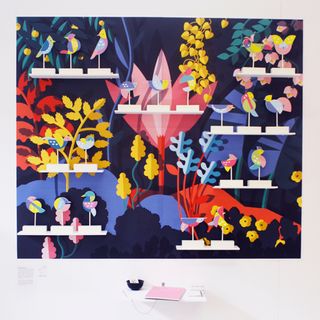20 pro tips for design graduates
Leading designers offer some top advice to design graduates gearing up to enter the creative industry.

"I wish they'd told me that when I graduated!" Young designers making their way in the world have said it time and again. So we decided to ask a range of established professionals what tips and advice they wish they'd been armed with when they finished their design courses.
From business skills to collaborative thinking, and on to over coming creative block, this top advice might just give you an extra edge in the competitive world of creativity…
01. Overcome creative block

Down in St Petersburg, Florida, Chris Parks aka Pale Horse has figured out his own personal technique for overcoming creative block. It saves him time when he has to get down and be creative.
"Figure out what triggers your mind to go into creative mode. Reading books like The War of Art, The Artist's Way and The Art of Learning will help. For me, it's two minutes of kettle bell swings, followed by 10 minutes of meditation.
Figure out what triggers your mind to go into creative mode
"Then I listen to Amy aka Spent Gladiator 1 by the Mountain Goats. It might sound weird, but doing this every day puts me into the mode where I am most effective and clear to receive input from the creative muse."
02. Stay teachable

Ryan Shelton, co-founder of digital design studio Noble Union, thought he had it all figured out when he left college, but when he looks back on his early work now he freely admits it really wasn't very good.
"One thing I've learnt since then is to stay teachable. Have a passion for learning and constantly refining your craft. As designers, we need to be open to critical feedback - both good and bad.
Get the Creative Bloq Newsletter
Daily design news, reviews, how-tos and more, as picked by the editors.
"Develop a willingness to be proven wrong and be open to modifying your designs and solutions appropriately. It's OK to be wrong. Having a willingness to accept feedback is the best way to grow and ultimately leads to the best design."
03. Place value on your work

Jason Kelly, the founder of Ochee Studio, believes that placing a value on your own work is a key ingredient to a successful career as a young designer. Don't waive the deposit just to land a client - you'll come to regret it.
"Clients that don't want to pay a deposit for work required usually tend to be the worse ones. If they don't want to pay it means they don't really value what you do. Keep away from these people! Always state the payment terms and what will be provided before commencing project."
04. Concentrate on personality

When you're applying for a design job, don't concentrate on what you'll get out of the job. Think of who you’ll be working for and what they’ll get, and the interview will go much better, says Gustavo Muñoz of Mexican studio Anagrama.
"When applying for a job, try to look for the things in your personality, work and aptitudes that will make the company that hires you better. I hate it when people apply for a job saying how we will help them become better designers. I am much more interested in creating win-win relationships. If the company can make you better as a designer and you can contribute to the company as well, everyone will be happy."
05. Don't rush

Illustrator Mick Marston graduated with a degree in graphic design from Leeds Metropolitan and today is a successful illustrator. It takes time to develop your own style, he says. Don't pilfer and don't rush it.
"Your style, if developed properly, should be a reflection of you and your personality. It should also keep on developing. I don't mean it should become totally different but it will be refined by new skills and different media.
Your style, if developed properly, should be a reflection of you and your personality
Your style can take years. You can't just suddenly mimic a style you like. Many people think it's OK to do this - I don't know how they sleep at night."
06. Learn to make good decisions

The graphic designer who created The Sopranos logo, Corey Holms, says that most college design projects assume that your client will be rational, and give you plenty of time to find the right solution. In the real world it's a different story.
"You will need to learn how to make good decisions, arrive at solid, good designs faster than you had to, and you have to be able to let go of them without getting disheartened with the project or the client. You will have great clients, but they aren't all going to be that way, and no amount of rationalisation or explanation can get past 'My wife doesn't like the color yellow…' "
07. Stay focused

Most of the projects you tackle will not max-out on your hottest design ideas, but don’t let this frustrate you, according to Rishi Sodha, who co-founded the design studio 2Creatives a few years back.
"You’re not going to be able to change the world with every project. It’s about striking an equilibrium and finding the challenge in what may seem mundane briefs, because, whilst they might not be the work you were expecting to do, they pay the bills and allow you to do the more fun work."
08. Be business savvy

Based in the great state of Pennsylvania, Joe Bosack has designed logos for some of North America's top professional and college sports teams. Looking back, he wishes business skills had played a larger role in his design education.
"I wish I had been taught more about the business of design, more specifically, the art of client maintenance and navigating the waters of change. In our business, fans are passionate about the brands we engage and that passion comes with a natural adversity to change. I could have used a course or two on processes of accepting change and the positives it can bring to an aging brand."
09. Be realistic

Start off with realistic ambitions, and hone your skills as you climb up the professional ladder. Kerning menu type might be what you're doing today, but in a few years your commissions will get bigger and better, says seasoned illustrator and designer Radim Malinic, aka Brand Nu.
"So you see those big, shinny designer portfolios full of high profile client work. The truth is that 99 per cent of those designers started on £50 flyer designs, small restaurant commissions and other projects where headaches were more common than big pay cheques.
"However, that's the path where you'll better your skills and build up your personal worth. A freelance illustrator or designer in advertising can make thousands per commission but be assured that did come with their first commission. Nor the second."
10. Set up a business plan

Kirsty Carter and Emma Thomas set up APFEL - A Practice for Everyday Life - in 2004. Today they work for clients like the V&A, the Barbican, Massive Attack and Wallpaper*. Here's there advice on setting up straight out of university:
"If you want to set up your own studio after graduating, it's really important to take the business side of things just as seriously as the design work.
Spend time writing up a comprehensive business plan, map out your objectives and the kind of work you want to do
"Spend time writing up a comprehensive business plan, map out your objectives and the kind of work you want to do, but also ask yourselves some tough questions. And get advice where you can! This is something we spent a lot of time doing when we were starting APFEL and we found it extremely valuable."
11. Develop strong relationships

Modern Dog is known on the design circuit across the USA thanks to the studio's brilliant poster and book work. And, of course, their lovely illustrations of dogs. Co-founder Robynne Raye shares her top advice for graduates:
"When I was just starting out I was interested in working for companies that produced cool projects, like snowboards and CD covers. I realized a few years into my career that it was more about developing and nurturing a strong client relationship that allowed me to take risks. I would rather work for a cool person who taught knitting classes than work for an insecure art director at a music label."
12. The client is key

When he was at university, Mr Dines of Studio Blup was a risk taker. He thought even then that his experimental side was being constrained by the systems being taught. Since leaving, he’s learned that clients are central and to push himself further.
"Your clients will be the reason you survive in this industry - this what they should have told me day one at university. Maintaining a client and keeping them happy with quality work will be at the top of your list once you've graduated and begin the path to design super stardom.
Your clients will be the reason you survive in this industry
"The level of work you produce for them has to exceed expectations so high so that they have no other choice but to keep coming back to you. Be transparent with your clients and say yes to any potential design projects they might throw your way. My rule is commit first, figure out later."
13. An agent isn't always the answer

With a bold and colourful illustration style and a head full of quirky humour and dazzling ideas, Erica Burns played the agent lottery as soon as she graduated. Now she's asking herself what she was thinking:
"After graduating I whole heartedly believed that the golden ticket to becoming a successful illustrator lay in the bagging of an agent. So when I got one I felt like I'd won the lottery - for about a month - until it dawned on me that I still didn't have a commission.
"You end up putting all your faith in somebody to find you work who may not even have the right client base for your style. If I could go back I would do more promotional work, sending out postcards, sticker bombing the London Underground!"
14. Keep organised records

Freelance illustrator Hennie Haworth began working with some of the UK’s biggest high street brands almost as soon as she'd graduated, but feels she'd have benefitted by a bit more business training on her course.
"I wish I'd been told about the business side of being a freelancer illustrator - the tax returns, keeping track of payments, how to invoice, keeping receipts… I have mainly learnt on the job and made up my own ways of keeping records, which I am sure could be better!
"For the tax returns I went on a couple of courses run by the local council. These were really helpful, and actually filling one out is quite straightforward as long as you've been organised through the year with your receipts and invoicing!"
15. Share your ideas

Stephane Faure is a Paris designer and illustrator whose Beesub studio works as part of a network of creatives. For him, the quicker you learn collaborative skills, the quicker your career will take off, whether you’re a freelancer or employee.
"Collaboration is not something many design schools really encourage. Most of the time they want to evaluate a student’s individual potential, methodology and ability. But it's different in the real world. HR departments and clients really want team player. So the sooner you are open up to sharing your ideas with others, and build projects in a common and collaborative way, the better."
16. Prepare for tight deadlines

Based in Leeds, Antony Kitson of OneTenEleven Media designs both print and digital campaigns for a range of clients. The difference between college project timescales and real work surprised him when he graduated.
"I wish they'd told me the difference between course work and real work when I graduated. I genuinely thought that as a professional designer I would get to work for three to six months on a creative project, when in reality clients want everything ASAP, or yesterday! It wouldn’t have put me off, but I would have been better prepared."
17. Don't let your education define you

Having studied both English and 2D animation, Duncan Beedie worked for a decade on programmes for BBC Three and doing character design work. Three years ago the Bristol-based creative’s career took an unexpected but successful swerve into freelance illustration.
"With 14 years of hindsight at my disposal since graduation, the one thing that I wish tutors had impressed upon me is that there is no one definitive career path. It's okay to shift focus and diverge. Whatever your diploma or degree says at the top does not define who or what you are."
18. Practise makes perfect

A freelance illustrator and concept artist, Nathan Aardvark has contributed to everything from books about pirates to Emmy-winning fantasy TV series like Da Vinci's Demons. For him, drawing, drawing and more drawing is what's helped him develop.
"Drawing from reference is actually the only thing I've found that's helped me develop my skills. It's not as exciting as drawing from the head but in the end you need to see drawing like learning a visual language, and your vocabulary is this library of image making techniques you carry around in your head.
The only way to learn a language is listen and repeat, or in this case study and reproduce
"The only way to learn a language is listen and repeat, or in this case study and reproduce. The more you do this the more you expand that vocabulary. Practice on everything from your favorite painters to photos to live subjects."
19. Help the client brief you

Swede Edvard Scott used to produce fantastic, abstract illustrations before helping found the design studio KOD & FORM. What he's discovered is that it isn't worth getting annoyed when a brief is inadequate. Instead, you need to help your client to brief you better.
"If you are hired as a designer the client has most likely needs help shaping or forming a message - they want to communicate. And in this situation you are the communication expert, therefore you cannot trust that they know exactly what to include in the brief.
"At KOD & FORM we sometimes give our clients brief templates, so that they know what information to give us. It's not at all unlikely that information they consider unnecessary is what sparks our initial ideas and becomes the foundation for a concept. Help the client brief you."
20. Keep it fresh

The American graphic designer Montana Forbes taught herself fashion illustration and turned it into a career. She has won clients as big as Harrods with her strong line work and simple colour palettes. For her, keeping fresh is what matters.
"In establishing yourself it's crucial to know your strengths and weaknesses, and whether or not to employ an agent can be vital to your career. Most successful illustrators I admire have interests and hobbies which not only inspire their work but sometimes act as stimuli to develop sideline projects and/or careers."
Words: Garrick Webster Illustration: Kiki Ljung
A freelance writer, editor and copywriter Garrick Webster is a former editor of Computer Arts who served for two spells on the magazine. He's previously judged the D&AD Student and New Blood awards, and in 2011, was part of the team that produced the charity illustrations book Memories.

Thank you for reading 5 articles this month* Join now for unlimited access
Enjoy your first month for just £1 / $1 / €1
*Read 5 free articles per month without a subscription

Join now for unlimited access
Try first month for just £1 / $1 / €1
The Creative Bloq team is made up of a group of design fans, and has changed and evolved since Creative Bloq began back in 2012. The current website team consists of eight full-time members of staff: Editor Georgia Coggan, Deputy Editor Rosie Hilder, Ecommerce Editor Beren Neale, Senior News Editor Daniel Piper, Editor, Digital Art and 3D Ian Dean, Tech Reviews Editor Erlingur Einarsson and Ecommerce Writer Beth Nicholls and Staff Writer Natalie Fear, as well as a roster of freelancers from around the world. The 3D World and ImagineFX magazine teams also pitch in, ensuring that content from 3D World and ImagineFX is represented on Creative Bloq.
